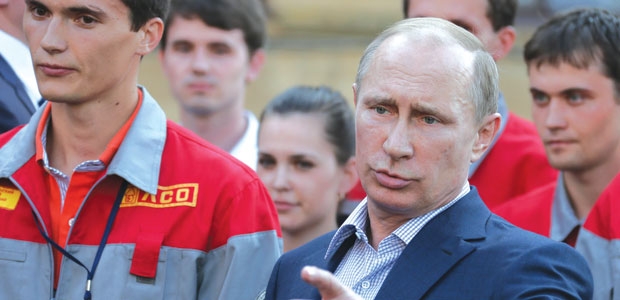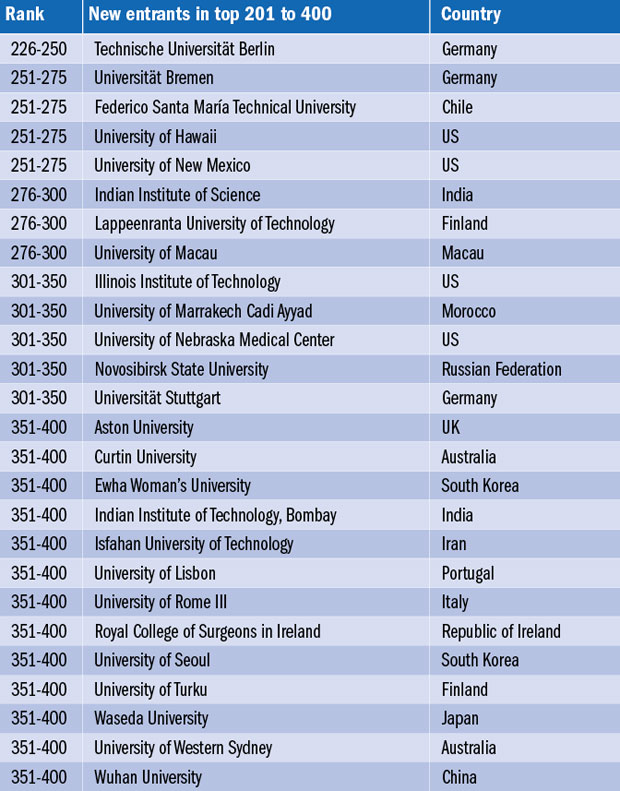 Source: Alamy
Source: Alamy
The large developing nations are making patchy progress in the rankings: will Putin’s ambitions be realised? Phil Baty reports.
The scale of the challenge facing developing countries in creating world-class universities is made clear by the Times Higher Education World University Rankings’ “best of the rest” list, which names the top 201 to 400 global institutions.
While 28 countries make the top 200, a further 13 feature in the 201-400 list – many of them developing economies that see their universities’ global competitiveness as key to their economic future. The large BRIC countries – Brazil, Russia, India and China – have 19 universities in this year’s rankings, but 15 are found in the 201-400 group.
Vladimir Putin, Russia’s president, wants five of the country’s universities to make the world top 100 by 2020, under the auspices of what is known as Project 5-100. In last year’s rankings, the difficulties of making this ambition a reality were laid bare when not a single Russian institution made the top 200 and only one, the flagship Lomonosov Moscow State University, made the top 400.
But in 2014-15, progress is evident: Lomonosov Moscow State has broken into the top 200 (joint 196th place) and Novosibirsk State University jumps straight into the 301-350 band, thanks to dramatic improvements in the impact and collaborative nature of its research.
Alexei Falaleev, office coordinator for Project 5-100, based at the Skolkovo Moscow School of Management, explains that the initiative’s mission is to “maximise the competitive position of a group of leading Russian universities in the global research and education market”, adding that “high positions in global university rankings are among the strongest indicators of the attainment of global competitiveness”.
Some 15 institutions were initially selected for support under the project, but that figure has already dropped to 14, as funding and support is gradually focused on a smaller number of institutions according to several key goals.
Investment is targeted on improving the content and quality of Russian university courses “in compliance with the best international standards”; enhancing the country’s research potential through personnel development and improved academic and student recruitment; and restructuring to “ensure the concentration of resources on breakthrough projects while abandoning ineffective activities”, Falaleev says.
Internationalising Russian higher education is central to Project 5-100. By 2020, each remaining participant must not only be listed in the global rankings top 200, but also enrol 15 per cent of its students and at least 10 per cent of its academic staff from overseas.
“The key result by 2020 will not only be the appearance of several strong universities in the country, but also a significant enhancement of the status and reputation of Russian education globally,” Falaleev says.
Although Russia currently lacks any top 100 institutions in the overarching tables, it is a different story in the subject-specific ones.
In engineering and technology, Moscow State takes 66th place, and in physical sciences it is one of three Russian top 100 institutions, alongside Novosibirsk (joint 85th) and the Moscow State Engineering and Physics Institute (95th).
Michael Fedoruk, Novosibirsk’s rector, explains that his university’s rise in the tables is the result of a number of factors, including a simple but highly effective project to ensure better recognition of its research output through the proper attribution of citations.
“The university has always been part of a large research conglomerate known to the outside world as the Academy of Science Siberian Branch, or more specifically the Academy’s Novosibirsk Scientific Center,” he says.
“Few know, however, that the Academy’s most active and successful researchers are at the same time professors at the university. A large number of its active researchers are involved in teaching with us, ensuring that the scientific centre’s work is already having a major influence on our undergraduate programme. But the university used to receive no credit for its professors’ research as it was incorrectly attributed solely to the Academy.”
Correct attribution has helped, but the backing of the Russian government has also been integral to Novosibirsk’s success, Fedoruk adds.
“From the start of the government’s university support programme, Novosibirsk has managed to consolidate its research base and bring its researchers back to the university,” he says.
“In doing so, the university has been able to capitalise on its unique position in the country…only Novosibirsk has the luxury of a campus that has, within 1 square mile, lecture theatres and 26 research institutes, including such large and internationally recognised organisations as the Budker Institute of Nuclear Physics and the Boreskov Institute of Catalysis.”
Russia is one step ahead of its great BRIC rivals, Brazil and India, as neither have top 200 representation.
Two Brazilian institutions make the top 400, however. The University of São Paulo is the country’s number one and sits marginally outside the top 200, rising this year from the 226-250 group to the 201-225 cohort. Its domestic counterpart, the State University of Campinas, remains in the 301-350 group it joined last year.
South America is also represented by Chile’s Federico Santa María Technical University (251-275) and Colombia’s University of the Andes (251-275).
India now has one fewer representative (four) in the top 400 than in 2013-14. Jointly leading the pack is a debutant – the Indian Institute of Science – which arrives in the 276-300 band. It was previously excluded from the rankings because it was a postgraduate school, but after starting to enrol undergraduates it became eligible for inclusion.
Anurag Kumar, its director, says: “The Indian Institute of Science [IISc] has over the past century provided its faculty and students with an atmosphere of academic freedom and encouragement to pursue fundamental or applied investigations in the field of science or engineering of their choosing.
“Among the students who choose to pursue postgraduate study in India, the best come to IISc. In most fields, it is the first choice for aspiring scientists eager to build their academic careers. Our facilities and laboratories are the best in the country and in many cases are world class. Such a situation has been created by generous direct government support, plus sponsored research funding from government departments and industry.”
He adds: “Strategically, having built up core strengths in the various branches of learning and research, IISc is poised to take on the challenges of interdisciplinary research that the problems facing humankind will inevitably require.”
IISc sits alongside last year’s Indian number one, Panjab University, which slips from the 226-250 band to the 276-300 group. The country’s remaining top 400 institutions are IITs – debutant the Indian Institute of Technology, Bombay and IIT Roorkee (both in the 351-400 group). There is no placing this year of IIT Delhi, IIT Kanpur or IIT Kharagpur.
Among the BRIC nations, China leads the way. Its overall representation in the top 400 grows this year from 10 universities to 11 – with Wuhan University entering the 351-400 band.
There are further encouraging signs. While the University of Science and Technology of China (201-225) and Nanjing University (251-275) remain in the same bands as last year, Shanghai Jiao Tong University rises from 301-350 to 276-300 and Sun Yat-sen University moves up a band to 301-350.
Ying Cheng, executive director of the Center for World-Class Universities at Shanghai Jiao Tong, says there are plenty of reasons to explain the rise of his and other Chinese institutions.
“I would say the most fundamental thing is our clear vision and strong will to become a world-class university,” he says. “In light of this vision, the university shifted the focus of its teaching, research, student recruitment and faculty promotion from domestic standards to international ones – from domestic competition to international competition.
“University staff have got used to what world-class universities do and have set that as their model and their goal.”
Cheng says that the most important initiatives have been toughening up the criteria for faculty recruitment; setting clear requirements for doctoral candidates to publish in leading journals; and strengthening collaborations with world-class universities outside the country.
And while a key challenge remains – overcentralised administrative systems that place too much power in the hands of managers at the expense of professors – Cheng has little doubt that China’s universities will continue to rise.
Phil Baty is editor, Times Higher Education Rankings.

Register to continue
Why register?
- Registration is free and only takes a moment
- Once registered, you can read 3 articles a month
- Sign up for our newsletter
Subscribe
Or subscribe for unlimited access to:
- Unlimited access to news, views, insights & reviews
- Digital editions
- Digital access to THE’s university and college rankings analysis
Already registered or a current subscriber? Login